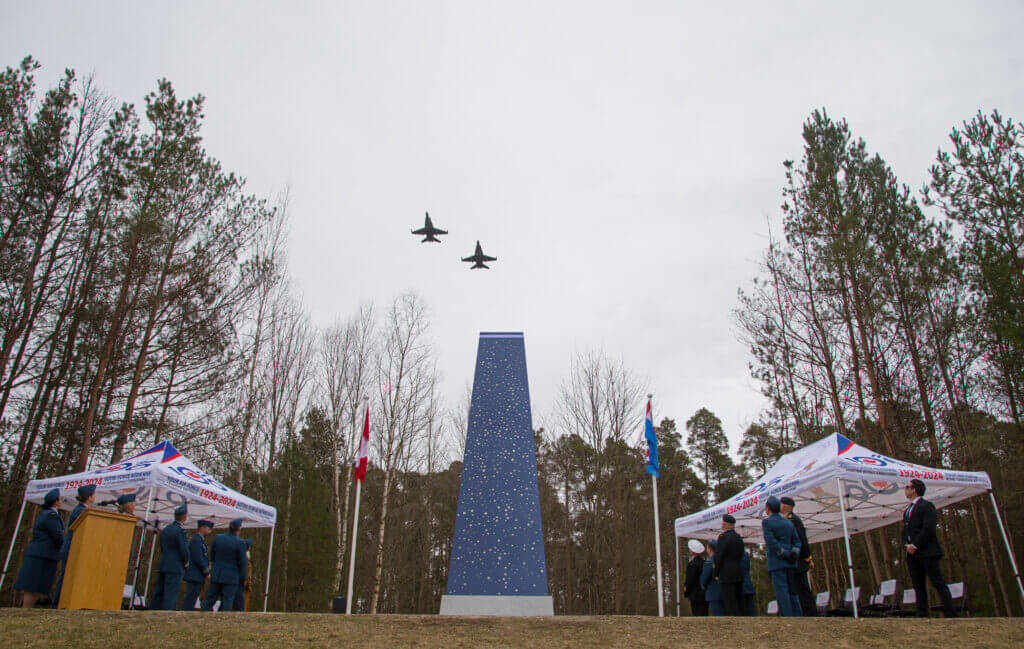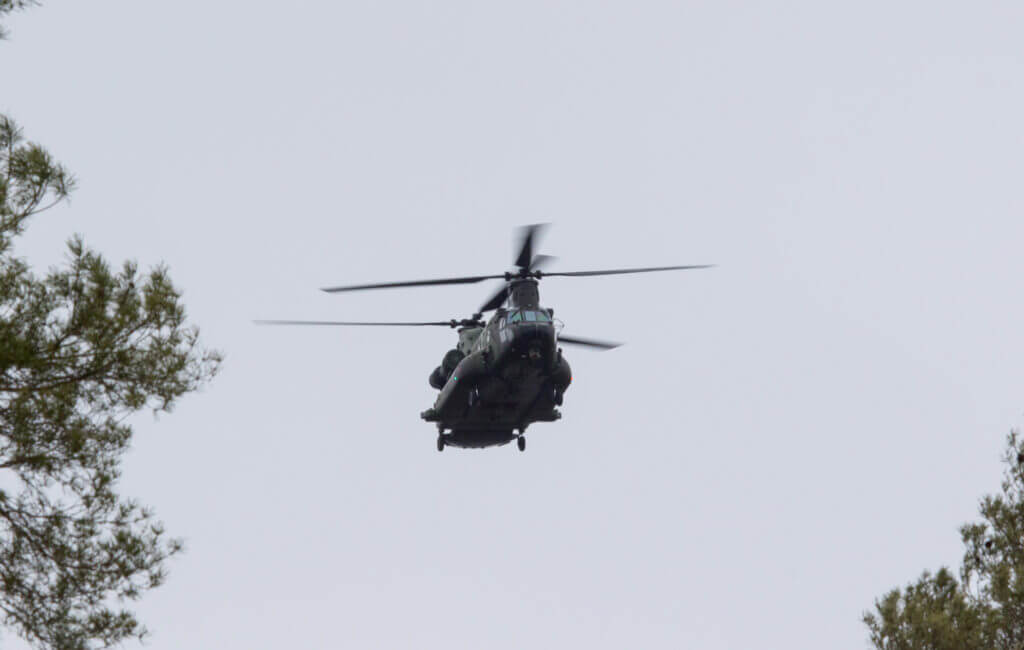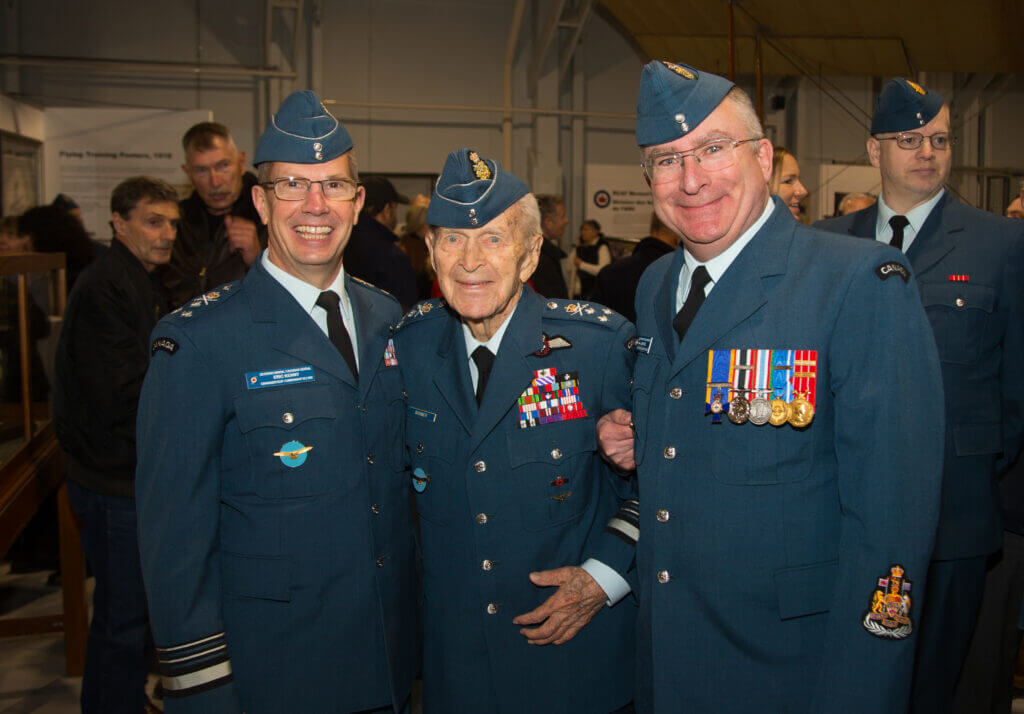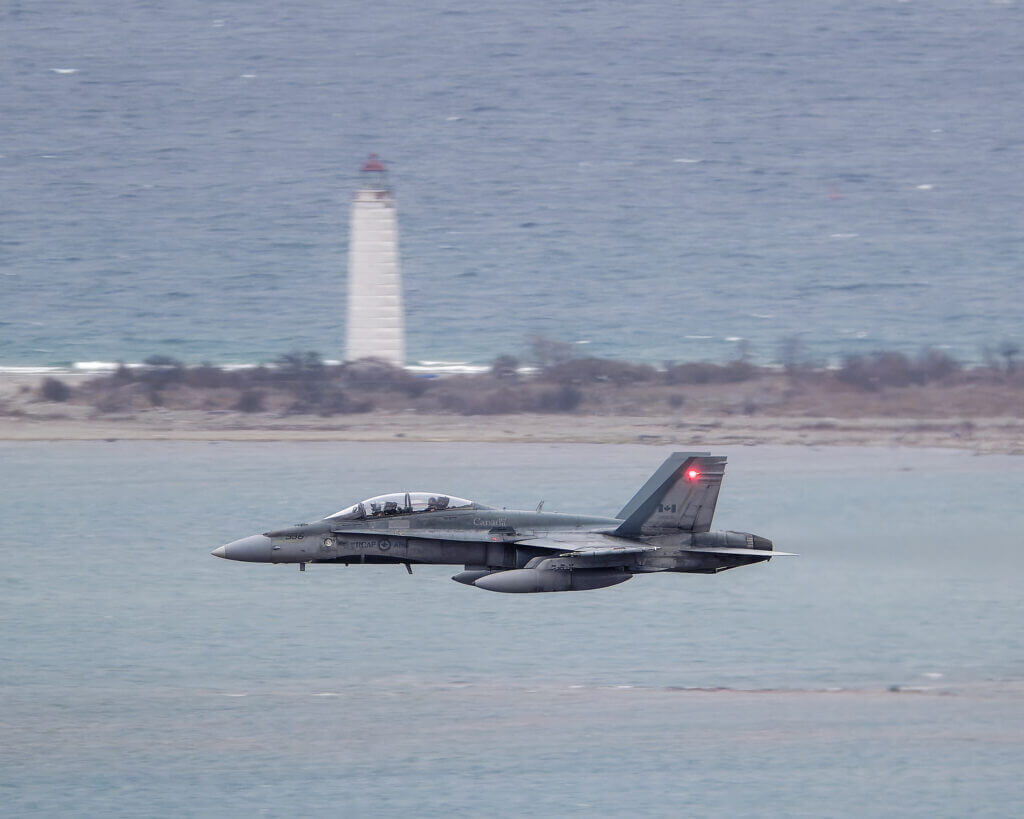Estimated reading time 15 minutes, 29 seconds.

On April 2, 2024, the unveiling of a long-awaited memorial to the Royal Canadian Air Force (RCAF) 100th anniversary took place at the main gate of Canadian Forces Base Borden.
Canada’s top military brass and hundreds of military personnel and civilians attended the ceremonial event — which took place one day after the RCAF officially marked its 100th birthday, due to the Easter holiday — as part of the RCAF’s Homecoming Day celebrations at Borden.
The Ad Astra Monument project was conceived by the 16 Wing Honorary Colonels three years ago to build an enduring memorial to commemorate the Air Force’s centennial, honour past and present serving members, and inspire the next generation of aviators.
Led by HCol Renee van Kessel of 16 Wing, HCol Wayne Hay of the Canadian Forces School of Aerospace Technology and Engineering, HCol Suzanne Farag of the Canadian Forces School of Aerospace Control Operations in Cornwall, and HCol Rory MacKinnon of the RCAF Academy, the monument was realized due in part to generous funding from over 20 individual donors.
The RCAF Foundation, created to propel the 100th anniversary program across the country, as well as Tom Jenkins, one of the authors of Pathway to the Stars, the official book of the 100th anniversary, helped sponsor the Ad Astra events of the day.

Ad Astra Monument
The monument, affectionately called “The Beacon” among the honorary colonel cadre, is a legacy project celebrating Borden’s rich military history. Intended to be a visual representation of the RCAF’s historical achievements, it honours and celebrates the legacy of all of those that have served over the past century and continue to serve.
Renowned local sculptor Marlene Hilton Moore was commissioned to create the monument. An accomplished artist, she has several other works on display at Borden. The monument features a strong vertical sloped metal dark blue pillar pointing to the sky, adorned with various sized small circles which are lit by LED lighting, representing the stars in the RCAF motto “Sic Itur Ad Astra” (Such is the Pathway to the Stars). The motto is emblazoned on the granite pedestal base upon which the memorial sits.
“Ad Astra was created as a lasting symbol to celebrate the illustrious history of the RCAF and a century of innovation, and to recognize the service of past and current RCAF aviators and their families,” said van Kessel. “It is a landmark to bridge this brilliant legacy of the past to the current RCAF personnel, and to inspire future generations of aviators who will serve Canada in its air force of the future.”

The RCAF Homecoming began with the grand reopening of the Hangar 11 of the Base Borden Military Museum, a national historic site. The hangar is a 106-year-old World War I facility, now featuring a newly designed gallery with display graphics by Garfield Ingram, president of the Great War Flying Museum. An Avro 504K and a de Havilland Tiger Moth trainer, used from the 1930s through the British Commonwealth Air Training Plan (BCATP) in the Second World War, are the centrepieces of the display. The theme of the renovated hangar is, “Forging the foundation of the RCAF, then and now.”
The guest of honour was the Honorary General of the Canadian Armed Forces, MGen (Ret’d) Richard Rohmer, who turned 100 in January and serves as honorary advisor to the Chief of the Defence Staff. He was a Mustang pilot in the Second World War, and later a Vampire pilot, and served as Wing Commander post-war until 1953. He rejoined the RCAF in the 1970s as an advisor, eventually becoming Commander of the Air Reserves.
“I hope that visitors see the importance Borden has played in their Air Force, and take away not only the history of Borden and the RCAF, but that they are inspired to see the future,” said LGen Eric Kenny, RCAF Commander.

“We are all here of one heart, one mind, and one intent — to celebrate the Air Force’s legacy of grit, and gallantry, individual courage, and institutional excellence,” said Gen Wayne Eyre, Chief of the Defence Staff. “It is a legacy that has served Canada, its Allies, partners, friends and the cause of freedom so well for the last 100 years. Who could imagine in the early days of the RCAF that generations later it would truly Slip the Surly Bonds of Earth as today 3rd Canadian Space Division and NASA is sending RCAF pilots to space and the first Canadian to the moon.”
The entourage of guests and attendees were then bussed to the Ad Astra Monument site located on a hill at the main gate. The bitter wind was daunting, but the precipitation held off. According to the honorary colonels, several logistical challenges almost prevented the new monument from being delivered in time. They apparently came very close to unveiling a large cardboard cutout.
“Having a 100-year anniversary for any service is a monumental moment in time and it called for an enduring representation of this legacy,” said van Kessel. “We needed an emblem of that time to resonate with Canadians today, to honour Canadians in the past who have served with the RCAF, and to hopefully build a bridge to inspire the future aviators and personnel of the RCAF.
“This is a moment the Honorary Colonels brought to life because we believe in being of service to our air force, and in this way, we are attempting to do that. This is for the men and women in uniform past, present and future, and for their families who have supported them.”

After the unveiling, a flight of two 433 Tactical Fighter Squadron CF-18 Hornets from 3 Wing CFB Bagotville, Que., did several flybys of the monument. A 450 Tactical Helicopter Squadron CH-147F Chinook then followed with a couple of spirited flypasts. (The Canadian Harvard Aircraft Association had hoped to participate, but inclement weather at their base of Tillsonburg, Ont., interfered.)
The last official action of the day was with the release of a new Canada Post stamp and first day cover commemorating the RCAF centennial, which was unveiled by LGen Kenny and MGen Rohmer and personnel from the Canadian Force Postal Unit.
The Homecoming Day concluded with a formal gala reception at Blue Mountain Resort in Collingwood, Ont., where junior officers and enlisted members were presented awards. The pair of CF-18s did a second flypast to cap an amazing day.
Borden’s Legacy
The RCAF has had a profound influence on the development and history of Canada, and has led allied operations during many conflicts. At its peak, during the Second World War, Canada had the fourth largest air force in the world.
Camp Borden, near Barrie, Ont., is the RCAF’s birthplace, where flying started in earnest in Canada. High losses of Royal Flying Corps aircraft and pilots in the early days of aerial warfare over the trenches in the First World War necessitated better pilot training. The Royal Flying Corps Canada (RFCC) was formed in 1917 to establish a significant training program for new aircrew.
Camp Borden was opened in 1916 as an army training base, with over 330,000 soldiers trained there by the end of the First World War. The base was the first purpose built military aerodrome in Canada, and the largest of five Royal Flying Corps Canada stations. A huge airfield was cleared of trees and stumps and a line of 18 Edwardian style hangars and support buildings was built on the sandy ground. Hangar 11 remains the sole example today and is the oldest standing hangar in Canada still in use.
Flying operations at Borden commenced in 1917 and supported the training of 1,884 pilots for the First World War — 60 per cent of the pilots trained in Canada. Flying operations wound down after the war in early 1919, but were reestablished under the Canadian Air Force in 1920 with an Imperial gift of 120 aircraft to further pilot training.
King George V granted Royal sanction to the Canadian Air Force on April 1, 2024, officially making it the Royal Canadian Air Force, in line with the Royal Air Force and other countries in the Commonwealth.

This solidified the RCAF as a permanent military service. RCAF Station Camp Borden became No.1 Flying Training Station, training new pilots on Avro 504Ks. In 1929 the first Canadian aerobatic team was formed flying Armstrong Whitworth Siskins.
During the Second World War, Borden formed an instrumental part of the BCATP, which was formed on December 17, 1939. New runways were paved, and buildings quickly went up. No.1 Service Flying Training School was the first flying BCATP school formed, and trained 2,728 Commonwealth pilots (1,790 Canadians) on Harvards and Ansons by the end of the war.
Following the war, technical training returned to Borden in 1946 as No.2 Technical Training School and has been there ever since. It was renamed Canadian Forces School of Aerospace Training and Engineering (CFSATE) after unification of the Canadian Forces and is still the largest school on the base.
In 1966, flying operations briefly returned to Borden as Primary Flying School was established, operating de Havilland Canada CT-122 Chipmunks. It moved out after unification in 1970. 400 Tactical Helicopter Squadron relocated to Borden from CFB Downsview in Toronto in 1996 and is now a maintenance squadron for the RCAF’s fleet of CH-146 Griffon helicopters.
Today, Borden remains the centre of RCAF aviation technical and maintenance training, overseen by 16 Wing and 2 Canadian Air Division — a testament to the longevity of the birthplace of Air Force. (It is also the military’s only tri-service base, training Army, Navy, and Air Force personnel in numerous trades.) Where better to honour the 100-year legacy of the RCAF than the home of vital training for this world class air force? The Ad Astra Monument will light the way.









I have good memories of attending the Airframe Tech course in 1956 and being a “cornflaker”.
Then 10 years later I attended the Technical Crewmembers course and was cross trained on engines, instrument and electrical trades. I served 20 years and continue to serve as a Legion Veterans Service Officer. I am proud of my training and service and wear the CD, SSM, QEII Diamond Jubilee, and Sovereigns Medal for Volunteers. I have been awarded the VA Ministers Commendation this year. Per Ardua ad Astra !